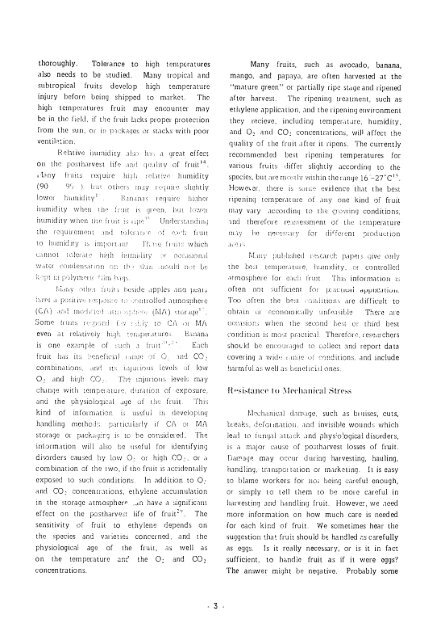7 - part
7 - part
7 - part
Create successful ePaper yourself
Turn your PDF publications into a flip-book with our unique Google optimized e-Paper software.
thoroughly. Tolerance to high tempcratures<br />
also needs to be studied. Many tropical and<br />
subtropical fruits develop high temperature<br />
injury before being shipped to market. The<br />
high temperatures fruit may encounter may<br />
be in the field, if the fruit Licks proper protection<br />
from the sun, or iipi<br />
ventilation.<br />
-skaesor stacks with poor<br />
Relative humidity atisO hocl a great effect<br />
on the postharvest life ird q(litli1v of frtit'<br />
'1 fny fruits rX uire hiih !0eliv . I hum idity<br />
(90 9T) ).bit otherS iAly rvJii.le slightly<br />
lower huiiiridit',/ Boios require higher<br />
humidity when in,, fiutt is qjirot. but se<br />
humridity when the fruit is; il, .I UderIta IlidgI<br />
the requirement lid tolcrkor r e! frti<br />
to hnrnidiTy 1.,ioport.ilt I 1e tilwhich<br />
cIIno t tolerate thih imriilty oc,.toti<br />
VIoter cOnollsetl'Ot on :, tC, i :tlt) :,t be<br />
Intpt to clvii ii 'am Vig'<br />
out :Jijyil r, side Ipples an"l talr<br />
a po u iv ,i n :nttiolled atinosphere<br />
(CA\) -Inl oci-. i. , ,l(A) *t .<br />
Some hlt.,s t(.:..rj',! ,; iv to CA ,)IMA<br />
evern at relatively igh o .it res. anana<br />
is one example of ,oshi fiuit: ' Eich<br />
fruit has its beneficial i wqut' o' 0 1nd CO<br />
cornbinations, and its i i-s levels of low<br />
0 and high CO Yh,.otjur ou:; levels; may<br />
chlange with tentpcelature, dilation of exposure,<br />
and the physiological 'gie oif th. fruit. This<br />
kind of inforniation i.;usefli in developing<br />
handling method: <strong>part</strong>icu orly if CA o, MA<br />
storage or packwgirg is to be considered. The<br />
imlormation will also be useful for identifying<br />
disorders caused by low 0- of high CO, , or a<br />
combination of the two, if the fruit is accidentally<br />
exposed to such conditions. In addition to 0<br />
and CO, concentrations, ethylene accumulation<br />
in the storage atmosphere -,n have a significant<br />
effect otn the postharvest life of fruit : '. The<br />
sensitivity of fruit to ethylene depends on<br />
the species and varieties concerned, and the<br />
physiological age of the fruit, as well as<br />
on the temperature ane the O and CO,<br />
concentrations.<br />
.<br />
.3<br />
Many fruits, such as avocado, banana,<br />
mango, and papaya, are often harvested at the<br />
'mature green" or artially ripe stoge and ripened<br />
after harvest. The ripening treatment, such as<br />
ethylene application, and the ripening environment<br />
they recieve, including temperatire, humidity,<br />
and O and CO, concentrations, will affect the<br />
quality of the fruit after it ripens. The currently<br />
recommended best ripening temperatures for<br />
various fruits differ slightly according to the<br />
species, but are rn o tlv within the range 16- 27 C'><br />
Howe~ar, there isscnwe evidence that the best<br />
ripening temperature of any one kind of fruit<br />
may vary accolding to the { owing conditions,<br />
rd therefore reos;sessrient of the temperature<br />
mal I;lVy he n'ese for different Drod uct ion<br />
l,: .;<br />
riMoti,' putllished resarch papers (iive only<br />
the bet:;tempeltute, humnidity, or controlled<br />
atmosphere for each fruit. Thi., intormation i:<br />
often riot sufficient fol : tIast.i dJppi.c [lull.<br />
Too often the b'st [s)itition,; are difficult to<br />
obtain ()Iecono[ically unfeasibLe There are<br />
occa;sion:, wtien the s;econd lest or third best<br />
condition is mo,;t practical. Therefore, resetrchers<br />
should be encouraged to collect an report data<br />
covering a wid, i tote ,t cod itions, and include<br />
harmful as well as beineficil ones.<br />
R-sistance to Mechanical St.res<br />
Mecha nical rlaniage, such as btuises, cuts,<br />
breaks, defoi nation, and invisible wound; which<br />
lead to funqal :itt,ck and )Iiys:o'ogical disorders,<br />
is a major cause of postharvest losses of fruit.<br />
Damage may occur dtiring harvesting, hauling,<br />
handling, transpo tation or marketing. It is easy<br />
to blame workers for noi being careful enough,<br />
or simply to tell them to be more careful in<br />
harvesting and handling fruit. However, we .aeed<br />
more information on how much care is needed<br />
for each kind of fruit. We sometimes hear the<br />
suggestion that fruit should be handled as carefully<br />
as eggs. Is it really necessary, or is it in fact<br />
sufficient, to handle fruit as if it were eggs?<br />
The answer might be negative. Probably some

















